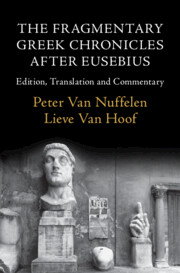Refine search
Actions for selected content:
17 results

The Fragmentary Greek Chronicles after Eusebius
- Edition, Translation and Commentary
-
- Published online:
- 11 September 2025
- Print publication:
- 24 July 2025
106 - Pseudo-Eusebius, Son of Pamphilus, Chronicle
-
- Book:
- The Fragmentary Greek Chronicles after Eusebius
- Published online:
- 11 September 2025
- Print publication:
- 24 July 2025, pp 310-332
-
- Chapter
- Export citation
109 - Theophilus, the Chronicler of Alexandria, Chronography
-
- Book:
- The Fragmentary Greek Chronicles after Eusebius
- Published online:
- 11 September 2025
- Print publication:
- 24 July 2025, pp 373-393
-
- Chapter
- Export citation
113 - Isidore the Deacon, Chronography
-
- Book:
- The Fragmentary Greek Chronicles after Eusebius
- Published online:
- 11 September 2025
- Print publication:
- 24 July 2025, pp 503-505
-
- Chapter
- Export citation
101 - Diodore of Tarsus, Chronicon
-
- Book:
- The Fragmentary Greek Chronicles after Eusebius
- Published online:
- 11 September 2025
- Print publication:
- 24 July 2025, pp 176-179
-
- Chapter
- Export citation
Introduction
-
- Book:
- The Fragmentary Greek Chronicles after Eusebius
- Published online:
- 11 September 2025
- Print publication:
- 24 July 2025, pp 1-58
-
- Chapter
- Export citation
104 - Panodorus, Chronography
-
- Book:
- The Fragmentary Greek Chronicles after Eusebius
- Published online:
- 11 September 2025
- Print publication:
- 24 July 2025, pp 190-214
-
- Chapter
- Export citation
105 - Annianus of Alexandria, Chronography
-
- Book:
- The Fragmentary Greek Chronicles after Eusebius
- Published online:
- 11 September 2025
- Print publication:
- 24 July 2025, pp 215-309
-
- Chapter
- Export citation
108 - Timothy of Apamea, Chronography
-
- Book:
- The Fragmentary Greek Chronicles after Eusebius
- Published online:
- 11 September 2025
- Print publication:
- 24 July 2025, pp 354-372
-
- Chapter
- Export citation
100 - Andreas, Brother of Magnus, Chronography
-
- Book:
- The Fragmentary Greek Chronicles after Eusebius
- Published online:
- 11 September 2025
- Print publication:
- 24 July 2025, pp 59-175
-
- Chapter
- Export citation
103 - Metrodorus, Chronicle and Easter Cycle
-
- Book:
- The Fragmentary Greek Chronicles after Eusebius
- Published online:
- 11 September 2025
- Print publication:
- 24 July 2025, pp 184-189
-
- Chapter
- Export citation
112 - Heron, Chronography
-
- Book:
- The Fragmentary Greek Chronicles after Eusebius
- Published online:
- 11 September 2025
- Print publication:
- 24 July 2025, pp 475-502
-
- Chapter
- Export citation
114 - Pyrrho, Chronicle
-
- Book:
- The Fragmentary Greek Chronicles after Eusebius
- Published online:
- 11 September 2025
- Print publication:
- 24 July 2025, pp 506-510
-
- Chapter
- Export citation
Chapter 8 - ‘Another X’
- from Part II - Lives and Afterlives
-
-
- Book:
- Writing Literary History in the Greek and Roman World
- Published online:
- 07 June 2024
- Print publication:
- 27 June 2024, pp 167-186
-
- Chapter
- Export citation
Chapter 4 - Zero-Degree Narrativity and the Registering Present
-
- Book:
- Tense-Switching in Classical Greek
- Published online:
- 27 January 2022
- Print publication:
- 17 February 2022, pp 233-265
-
- Chapter
-
- You have access
- Open access
- HTML
- Export citation
Chapter 10 - Mea tempora: Patterning of Time in Ovid’s Metamorphoses
-
- Book:
- Explorations in Latin Literature
- Published online:
- 05 August 2021
- Print publication:
- 19 August 2021, pp 183-203
-
- Chapter
- Export citation
Chapter 1 - Sappho’s Lives
- from Part I - Contexts
-
-
- Book:
- The Cambridge Companion to Sappho
- Published online:
- 09 April 2021
- Print publication:
- 29 April 2021, pp 11-21
-
- Chapter
- Export citation
